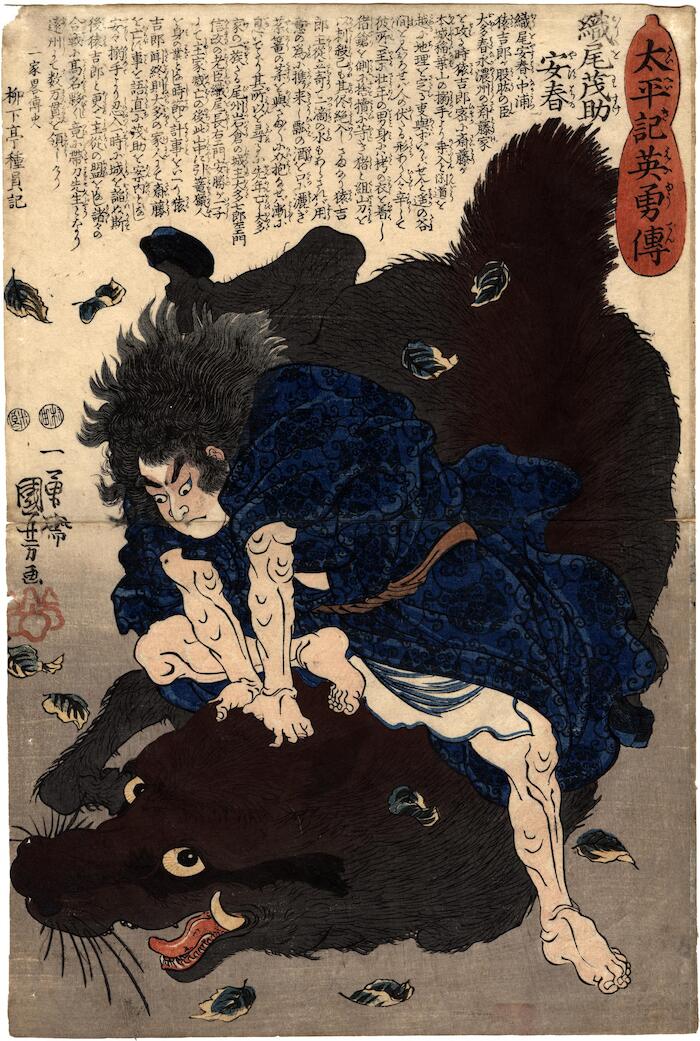Utagawa Kuniyoshi (歌川国芳) (artist 11/15/1797 – 03/05/1861)
Orio Masuke Yasuharu (織尾茂助安春) wrestling a wild boar from the series Taiheiki eiyuden ('Heroes of the Great Peace' - 太平記英勇傳) - no. 23
ca 1848 – 1850
9.7" x 14.4" Japanese woodblock print
Signed: Ichiyūsai Kuniyoshi ga (一勇斎国芳画)
Artist's seal: kiri
Censor seals: Mera and Murata
British Museum
Museum of Oriental Art, Venice (via Ritsumeikan University)
Marega Collection, Università Pontificia Salesiana (via Ritsumeikan University) Orio Mosuke Yasaharu was the historical Horio Yoshiharu.
The British Museum says that the publisher of their copy was Yamamotoya Heikichi.
****
Illustrated in black and white in 'Pictorial formulae of martial attributes in Kuniyoshi's warrior prints' by Elena Varshavskaya in Andon, September 1998, fig. 8, p. 7. Varshavskaya wrote on pp. 8-9: "One of Kuniyoshi's favourite devices to accentuate a hero's strength was to depict the person in a struggle with a giant animal. There are numerous pictures of fights against gigantic ghost cats, enormous snakes and dragons; familiar are the prints depicting Oniwakamaru struggling with a huge carp, Miyamoto Musashi subduing a giant whale, Kato Kiyomasa fighting tigers in the snow and many others. Repeatedly encounters with wild boars were portrayed. Among them are the pictures of Tadatsune and a giant boar, of the Emperor Yuryaku fighting a boar from the series Twelve Signs of the Zodiac and also Yoritomo's hunting party at the foot of Mt. Fuji. A print from the Taiheiki set gives such an example as well. Horio Mosuke Y oshiharu, called Orio Mosuke Yasuharu (fig. 8) in the print is depicted riding an enormous boar. Fights with wild boars are part of a developed literary tradition that was started by Nihongi and that is present in many stories of masculine valour. (Of course it can also mean that there were a lot of wild boars in the woods of the country and that encounters with them were far from rare). The portrait of Horio Yoshiharu is based on the following story. When in 1564 Nobunaga was attacking Inabayama castle, which belonged to Saito Tatsuoki, a plan was suggested by Hideyoshi, according to which only he and his servant would get inside the castle to investigate the situation. Hideyoshi and his companion had stopped for a moment to rest since they had to_ cross steep mountains when all of a sudden they heard a loud noise and a young man struggling with a wild boar of a rare size appeared before them. It didn't take too long for the young man to kill the boar though it was quite an effort. Admiring the hunter's strength and skill, Hideyoshi later made Horio his vassal. Kuniyoshi depicts the lad on top of the giant animal, exerting all his power. (Here the artist dresses the hunter in such a way as to leave his muscled arms and legs exposed to the spectator, a device mentioned earlier)."
The author continued: "The print stands out for the boldness of its design. The boar rushing down from above occupies the major part of the sheet, vividly demonstrating that only superhuman power can bring victory over such a creature."
****
The text reads:
織尾安春は中浦猿吉郎が股肱の臣太多春永濃州の斎藤家を攻る時猿吉郎密に斎藤が本城稲葉山の搦餌より乗入と閑道を越に地理を定る事与ず いかゞはせんと遥の谷間を見おろせば人の伏ある形あり 人々辛して彼所へ至に壮年の男身には栲の衣を着し猪鎗を側に捨犢に等しき猪と組山刀を以刺殺 己も其儘絶入しさまなり 猿吉郎主従立寄て一滴の水もあらされば用意の為に携来し瓢の酒を口に灑ぎ薬籠の薬を与さま/”\に介抱なせば漸に息はいでたり 其所以を尋るに先年亡し大多家の一族たる尾州岩倉の城主大多七郎左衛門信政の老臣織尾長右衛門安勝が一子にて主家滅亡の後此山中に引籠狩人を身の業となし時節を計事をいへり 猿吉郎聞終則大多の家人にて斎藤を亡す事を語 直に茂助を案内となし安々搦手より忍入一時に城を陥ぬ 斯後猿吉郎と更て主従の盟をなし諸々の合戦に高名夥く竟に帯刀先生となり遠州にて数万貫を領しけり 一家略伝史 柳下亭種員記
warrior prints (musha-e - 武者絵) (author)
